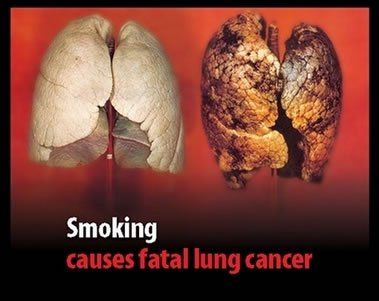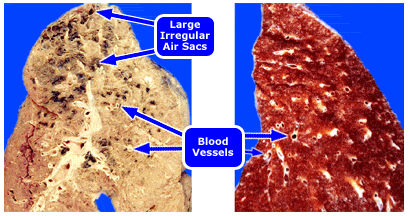"Dr. Duane Carr - Professor of Surgery at the University of Tennessee College of Medicine, said this: "Smoking does not discolor the lung."And Brigitte even found a Youtube video:
Dr. Victor Buhler, Pathologist at St. Joseph Hospital in Kansas City: "I have examined thousands of lungs both grossly and microscopically. I cannot tell you from exmining a lung whether or not its former host had smoked."
Dr. Sheldon Sommers, Pathologist and Director of Laboratories at Lenox Hill Hospital, in New York: "...it is not possible grossly or microscopically, or in any other way known to me, to distinguish between the lung of a smoker or a nonsmoker. Blackening of lungs is from carbon particles, and smoking tobacco does not introduce carbon particles into the lung."
There is even this (in German) in which a forensic medic states that these "tar" lungs do not exist.Rich White's Smoke Screens reports the same:
This was confirmed by Dr Jan Zeldenrust, a Dutch pathologist for the Government of Holland from 1951 - 1984. In a television interview in the 1980′s he stated that, translated from Dutch, "I could never see on a pair of lungs if they belonged to a smoker or non-smoker. I can see clearly the difference between sick and healthy lungs. The only black lungs I've seen are from peat-workers and coal miners, never from smokers".Nevertheless, the black lungs are all over cigarette packets these days.
And black lung disease (or pneumoconiosis) is a real disease. Coal miners get it.
So where does the smokers' black lung idea come from?
Part of the answer can be found in a photo-essay on Medicinenet:
This photo essay will focus on smoker's lung. The term "smoker's lung" refers to the structural and functional abnormalities (diseases) in the lung caused by cigarette smoking. First, the normal structure and function of the lung will be described and illustrated. Then, the structural and functional abnormalities caused by smoking will be described and illustrated.A bit further on the effect of emphysema on lungs is described.
As a result, emphysema also disrupts the normal blood supply. Figure 4 contrasts the nasty appearance of a smoker's emphysematous lung with a normal lung.So it's emphysema that causes the nasty appearance of a smoker's emphysematous lung.
It continues:
As you can imagine, cigarette smoke contains many impurities that are inhaled in great numbers directly into the lung. For this reason, the alveolar spaces of the smoker contain numerous scavenger cells (macrophages) that are filled with engulfed (phagocytized) particles of impurities and debris, as illustrated in Figure 5.I'm not sure why people are asked to 'imagine' what's in tobacco smoke. But since the emphysematous lung has simply been renamed the 'smoker's lung', maybe it's necessary to explain why it's turned grey-black. And it's that imaginary stuff in tobacco smoke that is conjured up to explain it.
Under the microscope, with this high magnification, you can actually see the black and brown engulfed particles in the alveolar scavenger cells. Indeed, smoker's lung may have so much of this particulate material that the lung looks gray-black to the naked eye. So, most of the time, you don't need a microscope to tell if someone is or was a heavy smoker. A naked eye examination of a smoker's lung usually will reveal an enlarged gray-black lung with enlarged air spaces (the emphysema, as you saw in Figure 4 and will see again in Figure 8).
The lie hinges on first asserting that smoking causes emphysema (it may do, or it may not), and secondly asserting that emphysema turns lungs grey-black (it probably does), and then finally dropping the connecting middle term of 'emphysema', and asserting that smoking turns lungs grey-black. Or it's just calling emphysematous lungs 'smokers' lungs'.
A parallel false ascription might be found elsewhere. People who visit Delhi may get food poisoning from ingesting bacteria. The food poisoning may cause vomiting and so on. But if the 'bacteria' link is missed out, and the malady is just called 'Delhi belly' (as it often is), it may mislead people into believing that it's visiting Delhi (or Indian restaurants) which is the root of the trouble - although in fact most visitors to Delhi (and Indian restaurants) don't suffer such ill-effects, and there are lots of other places in the world other than Delhi where you can contract 'Delhi belly'.
It's a thoroughly dishonest and disreputable mis-attribution of a disease. It pins the disease on a particular social group: smokers. And it makes it their disease, and nobody else's - even though not everyone who gets emphysema is a smoker, and not all smokers get emphysema. But at least we may now see why pathologists aren't finding grey-black smokers' lungs: they didn't have emphysema.
But this doesn't seem to be the only way the black lung lie is propagated. There are also the pigs' lungs used in demonstrations. I even found an ad for one:
The accompanying text helpfully explains:
The inflatable swine lungs have been stained realistically and then specially preserved by the BioFlex odorless, nontoxic process that retains the texture and elasticity of fresh lungs. The lungs dramatically and unforgettably demonstrate the effects of prolonged smoking. A palpable simulated internal tumor and a physical simulated external tumor encourage students to feel the texture of the lungs, and to remember that smoking is a known cause of lung cancer.So firstly they're pig lungs. And secondly they've been preserved and stained realistically. And simulated internal and external tumours have been added. And all to demonstrate the effects of prolonged smoking! It beggars belief.
No doubt the students aren't told any of this, and are led to believe that they're looking at real human 'smokers' lungs'.
There are even discussions of the effectiveness of such imagery.
Marketing researchers at the University of Arkansas, Villanova University and Marquette University surveyed more than 500 U.S. and Canadian smokers and found that the highly graphic images of the negative consequences of smoking have the greatest impact on smokers' intentions to quit. The most graphic images, such as those showing severe mouth diseases, including disfigured, blackened and cancerous tissue, evoked fear about the consequences of smoking and thus influenced consumer intentions to quit.In fact, there may be a downside from using such graphic images, if they have been fraudulently obtained (a consideration which doesn't appear to have crossed the minds of the marketing researchers). And we've just established two methods by which they are fraudulently obtained.
"These results suggest that there appears to be little downside on intentions to quit from using extremely graphic pictorial depictions of the negative health outcomes due to smoking," said Scot Burton, co-author of the study and marketing professor in the Sam M. Walton College of Business.
And the downside is that, when it is shown that they're fraudulent, the people who publish them will be accused of fraud, of twisting logic and manufacturing evidence. And when that happens, people will cease to believe not just the fraudulent evidence they have produced, but everything else that they assert too. They will lose all their credibility. Nobody will believe a word they say.
That's quite a big downside, I think. And it's a downside that doesn't even seem to have occurred to them.
It doesn't seem to have occurred to the mass media that help propagate these lies that people will cease to believe a word they say either.
Nor does it seem to have occurred to the medical profession which allows these lies to be propagated unchallenged that people will cease to believe them too.
There's an awful lot of downside waiting to go down.
Update: The lying is deliberate. From the Delaware News Journal:
Pankiw described the centerpiece of his anti-smoking display as the diseased lung of a 150-pound man who smoked for 15 years. Actually, it was a pig's lung shot full of various carcinogens on purpose, but, Pankiw said later, his lesson was made stronger by not passing along that tidbit of truth.And furthermore smokers' lungs are routinely used in lung transplants:
In the UK donors with a positive smoking history provide nearly 40% of the lungs available for transplantation, according to the study's lead author Professor Robert Bonser, of the Queen Elizabeth Hospital, Birmingham and University of Birmingham. He said in a press statement: "Our data show that patients awaiting lung transplantation in the UK are likely to survive longer if they are willing to accept lungs from any suitable donor, irrespective of smoking history...






I like reading SOTT but what is with these ill informed "smoking is all right" articles of late? The first article kept prattling on about how nicotine is good for you. Yes, pure nicotine has its medical uses and is better for you than coffee some say BUT when you smoke you are not taking in pure nicotine you are taking in all sorts of other chemicals in the smoke as well. Like they tell us meat done on a BBQ is cancerous. Nicotine is also one of the most addictive substances on the planet. Who cares whether people faked black lungs to display lung cancer, people who smoke do have tar in their lungs and lesions etc and diseased lungs are not pretty pink flesh anymore. Not only that there are a legion of other medical problems created by smoking. Maybe in a perfect world where we eat the perfect diet with no contamination in the ecosphere smoking may not harm people but I find it extremely offensive in the same vane as people who talk on their mobiles while supposedly having dinner with you or in picture theaters. It has been patently proven that enclosed areas are healthier and cleaner without smokers. As a non smoker I find it a disgusting habit pushed on me in public places, the stench of it all!. Kiss a non smoker and taste the difference. If you want to smoke fine, but don't do it in my air space and grow your own organic tobbaco!